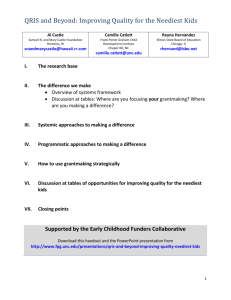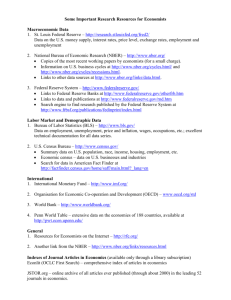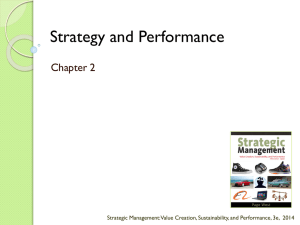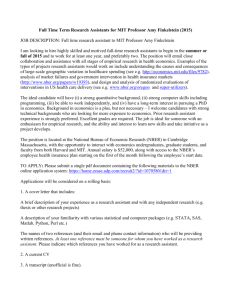Macroeconomics Annual 2012, Volume
advertisement
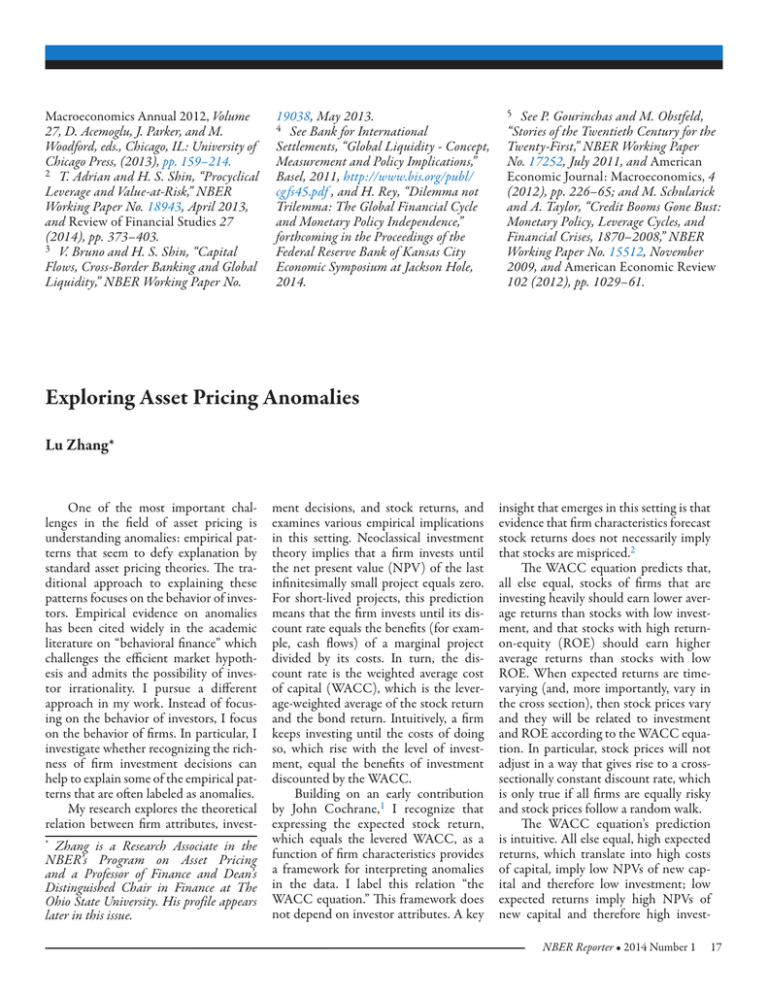
Macroeconomics Annual 2012, Volume 27, D. Acemoglu, J. Parker, and M. Woodford, eds., Chicago, IL: University of Chicago Press, (2013), pp. 159–214. 2 T. Adrian and H. S. Shin, “Procyclical Leverage and Value-at-Risk,” NBER Working Paper No. 18943, April 2013, and Review of Financial Studies 27 (2014), pp. 373–403. 3 V. Bruno and H. S. Shin, “Capital Flows, Cross-Border Banking and Global Liquidity,” NBER Working Paper No. 19038, May 2013. 4 See Bank for International Settlements, “Global Liquidity - Concept, Measurement and Policy Implications,” Basel, 2011, http://www.bis.org/publ/ cgfs45.pdf , and H. Rey, “Dilemma not Trilemma: The Global Financial Cycle and Monetary Policy Independence,” forthcoming in the Proceedings of the Federal Reserve Bank of Kansas City Economic Symposium at Jackson Hole, 2014. See P. Gourinchas and M. Obstfeld, “Stories of the Twentieth Century for the Twenty-First,” NBER Working Paper No. 17252, July 2011, and American Economic Journal: Macroeconomics, 4 (2012), pp. 226–65; and M. Schularick and A. Taylor, “Credit Booms Gone Bust: Monetary Policy, Leverage Cycles, and Financial Crises, 1870–2008,” NBER Working Paper No. 15512, November 2009, and American Economic Review 102 (2012), pp. 1029–61. 5 Exploring Asset Pricing Anomalies Lu Zhang* One of the most important challenges in the field of asset pricing is understanding anomalies: empirical patterns that seem to defy explanation by standard asset pricing theories. The traditional approach to explaining these patterns focuses on the behavior of investors. Empirical evidence on anomalies has been cited widely in the academic literature on “behavioral finance” which challenges the efficient market hypothesis and admits the possibility of investor irrationality. I pursue a different approach in my work. Instead of focusing on the behavior of investors, I focus on the behavior of firms. In particular, I investigate whether recognizing the richness of firm investment decisions can help to explain some of the empirical patterns that are often labeled as anomalies. My research explores the theoretical relation between firm attributes, investZhang is a Research Associate in the NBER’s Program on Asset Pricing and a Professor of Finance and Dean’s Distinguished Chair in Finance at The Ohio State University. His profile appears later in this issue. * ment decisions, and stock returns, and examines various empirical implications in this setting. Neoclassical investment theory implies that a firm invests until the net present value (NPV) of the last infinitesimally small project equals zero. For short-lived projects, this prediction means that the firm invests until its discount rate equals the benefits (for example, cash flows) of a marginal project divided by its costs. In turn, the discount rate is the weighted average cost of capital (WACC), which is the leverage-weighted average of the stock return and the bond return. Intuitively, a firm keeps investing until the costs of doing so, which rise with the level of investment, equal the benefits of investment discounted by the WACC. Building on an early contribution by John Cochrane,1 I recognize that expressing the expected stock return, which equals the levered WACC, as a function of firm characteristics provides a framework for interpreting anomalies in the data. I label this relation “the WACC equation.” This framework does not depend on investor attributes. A key insight that emerges in this setting is that evidence that firm characteristics forecast stock returns does not necessarily imply that stocks are mispriced.2 The WACC equation predicts that, all else equal, stocks of firms that are investing heavily should earn lower average returns than stocks with low investment, and that stocks with high returnon-equity (ROE) should earn higher average returns than stocks with low ROE. When expected returns are timevarying (and, more importantly, vary in the cross section), then stock prices vary and they will be related to investment and ROE according to the WACC equation. In particular, stock prices will not adjust in a way that gives rise to a crosssectionally constant discount rate, which is only true if all firms are equally risky and stock prices follow a random walk. The WACC equation’s prediction is intuitive. All else equal, high expected returns, which translate into high costs of capital, imply low NPVs of new capital and therefore low investment; low expected returns imply high NPVs of new capital and therefore high investNBER Reporter • 2014 Number 1 17 ment. In addition, high ROE relative to low investment must imply high costs of capital, which are necessary to offset the high ROE to induce low NPVs for new capital and therefore low investment. Conversely, low ROE relative to high investment must imply low costs of capital, which are necessary to offset the low ROE to induce high NPVs for new capital and therefore high investment. My co-authors and I evaluate the empirical power of the WACC equation using factor regressions, a standard technique in empirical finance that relates the return on a security to the contemporaneous returns on a number of “factors.” In one of the most widely cited applications of such factor models, Eugene Fama and Kenneth French specify three factors: the excess return on the overall stock market (the market factor), the return spread between small and large stocks, and the return spread (the value factor, denoted HML) between value stocks (with high book value of equity relative to the market value of equity) and growth stocks (with low book value of equity relative to the market value of equity).3 Mark Carhart subsequently forms a four-factor model by adding to the Fama-French model the return spread (the momentum factor, denoted UMD) between winners (stocks with high prior six- to twelve-­month returns) and losers (stocks with low prior six- to twelvemonth returns).4 The Carhart four-factor model is the current empirical benchmark for estimating expected returns in academic research and in investment management practice. Motivated by the WACC equation, my co-authors and I propose a new four-factor model which we label the “q-model” that includes the market factor, a size factor, an investment factor, and an ROE factor. With a few exceptions, the q-model’s performance is at least comparable to, and often better than, that of the Carhart model in explaining a comprehensive list of anomalies in factor regressions. A comparative advantage of the q-model is its economic motivation. We construct the size, the investment, and the ROE factors from twoby-three-by-three sorts of stocks based 18 NBER Reporter • 2014 Number 1 on size (market equity), investment-toassets, and ROE. The investment factor is the difference (low-minus-high) between the simple average of the returns on the six low investment portfolios and the simple average of the returns of the six high investment portfolios. The ROE factor is the difference (high-minuslow) between the simple average of the returns on the six high ROE portfolios and the simple average of the returns of the six low ROE portfolios. From January 1972 to December 2012, the investment factor earned an average return of 0.45 percent per month, and the ROE factor earned on average 0.58 percent. Both average returns are statistically distinguishable from zero. The investment factor has a high correlation of 0.69 with the value factor, HML, and the ROE factor has a high correlation of 0.50 with the momentum factor, UMD. The Carhart four-factor model has difficulty explaining our factor returns, but the q-model can explain the Carhart factor returns. The evidence suggests that HML and UMD might be noisy versions of our new factors. More importantly, using a set of 33 anomalies that are significant in the broad cross section, we show that the q-model performs well relative to the Carhart model. Across the 33 high-minus-low decile portfolios, the average magnitude of the unexplained average returns is 0.21 percent per month in the q-model, which is lower than 0.34 percent in the Carhart model and 0.55 percent in the FamaFrench model. The number of anomalies still associated with unexplained average returns is also much lower: 4 for the q-model, 18 for the Carhart model, and 25 for the Fama-French model. The q-model’s performance, combined with its economic motivation, suggests that it might be able to serve as a new empirical workhorse for estimating expected returns.5 Fama and French (2013) have recently incorporated variables that resemble our new factors into their three-factor model to form a five-factor asset pricing model.6 My co-authors and I also explore a dynamic model with corporate income taxes and debt, and design a novel asset pricing test by matching average levered WACCs to average stock returns across different sets of testing portfolios. The results provide some support for our investment approach, and suggest that the WACC equation can explain a substantial portion of the spreads in average stock returns of portfolios sorted on unexpected earnings, book-to-market equity, and capital investment. The average magnitude of the model errors across ten unexpected earnings deciles is 0.7 percent per annum, which is lower than 4 percent from the Fama-French model. The highminus-low decile has an error of –0.4 percent in our model, in contrast to 14.1 percent from the Fama-French model. Across ten book-to-market deciles, the average absolute error is 2.3 percent, which is comparable with 2.8 percent in the FamaFrench model. However, the high-minuslow error is only 1.2 percent in our model relative to 7.3 percent in the Fama-French model. As such, portfolios of firms seem to do a good job of aligning investment with costs of capital. One weakness is that our estimates of capital’s share and the adjustment cost parameter vary across different sets of the testing portfolios.7 We also apply our dynamic WACC model to price momentum and earnings momentum, two important anomalies in the cross section. To this end, we refine our empirical procedure by measuring monthly levered WACCs using annual accounting data. Because the stock composition of momentum portfolios changes monthly, portfolio fundamentals such as investment also vary monthly even though firm-level fundamentals are constant within a fiscal year. Since winners (stocks with high unexpected earnings or high short-term prior returns) have higher expected investment growth than losers (stocks with low unexpected earnings or low short-term prior returns) the dynamic WACC model succeeds in accounting for average momentum profits. In addition, as the expected investment growth spread between winners and losers converges within 12 months after the portfolio formation in the data, momentum profits predicted in the model also converge within 12 months as in the data.8 To understand the value premium, I also develop a dynamic, quantitative investment model in which asymmetric adjustment costs of capital and the countercyclical price of risk combine to cause assets in place to be harder to adjust downward (and therefore riskier) than growth options, especially in bad times when the price of risk is high.9 This model’s key prediction that value stocks are riskier than growth stocks in bad times seems to contradict conventional wisdom. My co-author and I address this seeming contradiction by defining the state of the economy based on the expected equity risk premium.10 Peaks are identified as periods with the 10 percent lowest market risk premiums, and troughs as periods with the 10 percent highest risk premiums. As the model predicts, the market beta of HML is positive (0.40) in troughs but negative (–0.33) in peaks, suggesting that at least part of the value premium is attributable to risk. Why do firm characteristics often seem to have more explanatory power than risk measures in explaining returns? My co-author and I offer suggestive evidence by showing that measurement errors in estimated betas can explain this pattern. For example, beta estimates from 36-month rolling-window regressions are average betas in the past three-year period, whereas the true beta is time-varying.11 J. H. Cochrane, “Using Production Based Asset Pricing to Explain the Behavior of Stock Returns over the Business Cycle,” NBER Working Paper No. 3212, January 1992, published as “Production-Based Asset Pricing and the Link Between Stock Returns and Economic Fluctuations,” The Journal of Finance 46 (1991), pp. 209–37. 2 X. Lin and L. Zhang, “Covariances versus Characteristics in General Equilibrium,” NBER Working Paper No. 17285, August 2011, published as “The Investment Manifesto,” Journal of Monetary Economics, 60 (2013), pp. 351–66. Some of the ideas discussed in this work first appear in L. Zhang, “Anomalies,” NBER Working Paper No. 11322, May 2005. 3 E. F. Fama and K. R. French, “Common Risk Factors in the Returns on Stocks and Bonds,” Journal of Financial Economics 33 (1993), pp. 3–56. 4 M. M. Carhart, “On Persistence in Mutual Fund Performance,” The Journal of Finance 52 (1997), pp. 57–82. 5 K. Hou, C. Xue, and L. Zhang, “Digesting Anomalies: An Investment 1 Approach,” NBER Working Paper No. 18435, October 2012. The estimates reported in this summary are from the updated sample through December 2012 and will appear in the next draft of this paper. An early incarnation of this work appears as “Neoclassical Factors,” NBER Working Paper No. 13282, July 2007. The insight that investment and ROE play a central role in the cross-section of returns within the neoclassical theory of investment is presented in Zhang, 2005, op. cit. 6 E. F. Fama and K. R. French, “A FiveFactor Asset Pricing Model,” Fama-Miller Working Paper, University of Chicago, November 2013. 7 L. X. Liu, T. M. Whited, and L. Zhang, “Investment-based Expected Stock Returns,” Journal of Political Economy 117 (2009), pp. 1105–39. This paper draws heavily on “Regularities,” NBER Working Paper No. 13024, April 2007. 8 L. X. Liu and L. Zhang, “A Model of Momentum,” NBER Working Paper No. 16747, January 2011. 9 L. Zhang, “The Value Premium,” The Journal of Finance 60 (2005), pp. 67–103. 10 See R. Petkova and L. Zhang, “Is Value Riskier Than Growth?” Journal of Financial Economics 78 (2005), pp. 187– 202. 11 Lin and Zhang, 2013, op. cit. NBER Reporter • 2014 Number 1 19 NBER Profile: Hyun Song Shin Hyun Song Shin is a Research Associate in the NBER’s Program on Corporate Finance and the HughesRogers Professor of Economics at Princeton University. His research interests cover financial institutions, risk, and financial stability issues, topics on which he has published widely both in academic and policy outlets. He is the author of Risk and Liquidity, which was the 2008 Clarendon Lecture in Finance, and co-authored the 2009 Geneva Report on The Fundamental Principles of Financial Regulation. Before moving to Princeton in 2006 he was based in the United Kingdom and held academic positions at the University of Oxford and at the London School of Economics. In 2010, he took leave from Princeton and served as the Senior Adviser on the International Economy to South Korea’s President Lee Myungbak. He will rejoin the policy world in 2014 as Economic Adviser and Head of Research at the Bank for International Settlements. NBER Profile: Lu Zhang Lu Zhang is a Research Associate in the NBER’s Program on Asset Pricing and the Dean’s Distinguished Chair in Finance and Professor of Finance at The Ohio State University. He is also an Associate Editor for the Journal of Financial Economics, and a co-founder (and President in 2013) of the Macro Finance Society, a newly established academic society devoted to advancing and disseminating high-quality research at the intersection of financial economics and macroeconomics. He received a Ph.D. in Finance from the University of Pennsylvania in 2002. Prior to joining Ohio State in 2010, he taught at the University of Rochester (2002–6) and the University of Michigan (2006–10). Zhang’s research focuses on asset pricing and its connections to macroeconom- ics, corporate finance, labor economics, and accounting. His recent work explores the implications of the neoclassical q-theory of investment for cross-sectional asset pricing and the linkage between labor market frictions and economic crises. His scientific articles have appeared in leading academic journals, and in 2005 he received the Smith-Breeden Award for best paper from the American Finance Association and The Journal of Finance for his work on “The Value Premium.” Zhang lives in Columbus, Ohio, with his wife, Yiqing, as well as one cat, Kiddy, and three parrots, Mango, Greenie, and Tilly. At work, he enjoys embarrassing (and being embarrassed by) his co-authors via Skype. At home, he enjoys playing the role of peacemaker between the cat and the birds. NBER Reporter • 2014 Number 1 21

